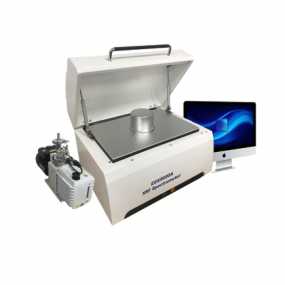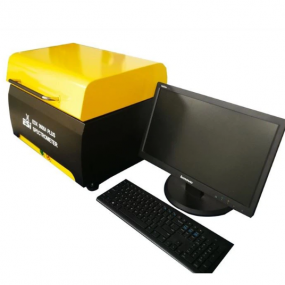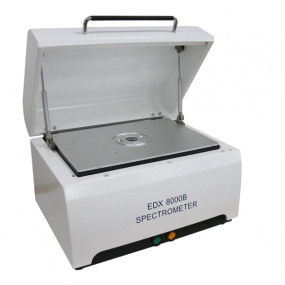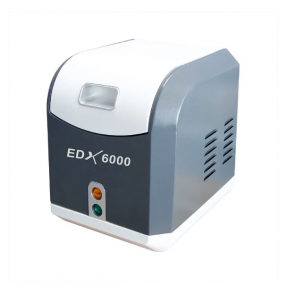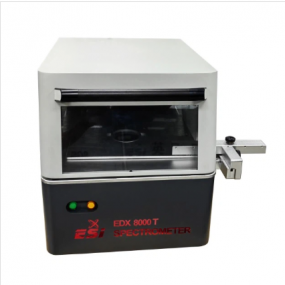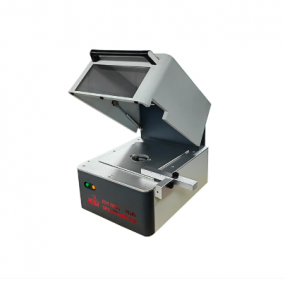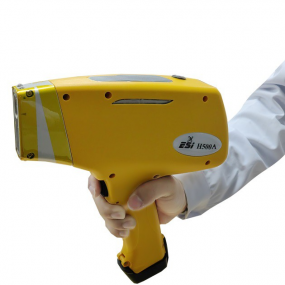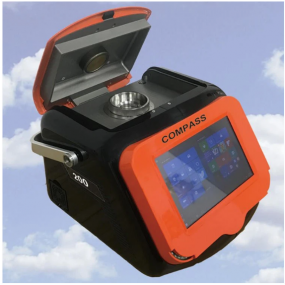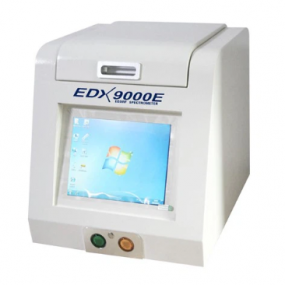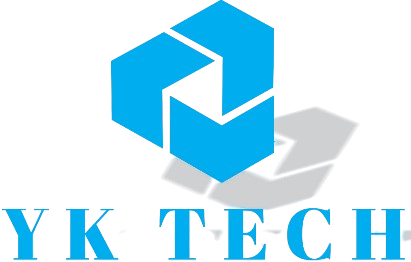EDX-8800G MAX XRF Spectrometer Floor-standing X-ray Fluorescence
-
64
-
0765 259 545
EDX-8800G MAX XRF Spectrometer Floor-standing X-ray Fluorescence
Model: EDX-8800G MAX XRF
EDX-8800G MAX XRF Spectrometer Floor-standing X-ray Fluorescence Spectrometer Simply the Best The latest generation of detector: High-throughput count rate and ultra-low resolution. Wider element detection range: Analysis covers elements from 9F (Fluorine) to 95Am (Americium) in the periodic...
Model: EDX-8800G MAX XRF
EDX-8800G MAX XRF Spectrometer Floor-standing X-ray Fluorescence Spectrometer Simply the Best The latest generation of detector: High-throughput count rate and ultra-low resolution. Wider element detection range: Analysis covers elements from 9F (Fluorine) to 95Am (Americium) in the periodic...
EDX-8800G MAX XRF Spectrometer Floor-standing X-ray Fluorescence
Model: EDX-8800G MAX XRF
Model: EDX-8800G MAX XRF
Simply the Best
The latest generation of detector: High-throughput count rate and ultra-low resolution.
Wider element detection range: Analysis covers elements from 9F (Fluorine) to 95Am (Americium) in the periodic table, and supports oxide analysis. Lower detection limit:
Capable of achieving concentration analysis in the range of 0.2 ppm to 99.99%. Composite target X-ray tube: Achieves better excitation effects for both light and heavy elements simultaneously.
Extra-large vacuum sample chamber: Adapts to the non-destructive testing of larger-sized samples.
One-click conversion between helium and vacuum testing environments: Meets diversified testing requirements.
Provides multiple data access interfaces: Enables compatibility with the LIMS (Laboratory Information Management System)
EDX8800G MAX Energy Dispersive Fluorescence Spectrometer - Materials Analysis Expert
The EDX8800G MAX can detect materials covering metals, ores, environmental samples, building materials, electronics, food products, cultural relics, etc. Its core application scenarios include composition analysis, quality control, safety compliance, scientific research and traceability, etc.
ESI EDX8800G MAX spectrometer is mainly applied in third-party laboratories and various places that require high-precision material composition analysis. The EDX8800G MAX focuses on the qualitative and quantitative analysis of major, minor, and trace elements or compounds in various materials. It can be widely used in the following fields: alloy materials, precious metals, iron ore powders, non-ferrous metals and powders, metallurgy, metallic and non-metallic mineral resources, refractory materials, refractory raw materials, titanium dioxide, gypsum, catalysts, ceramics, cement, lime, the glass industry, quartz, feldspar, calcite, clay, rock wool, soil, solid waste, dust removal ash, red mud, fly ash, rare earth permanent magnets, petroleum products, furnace slag, etc. It can conduct rapid qualitative and quantitative analysis of the chemical compositions of production raw materials and finished products, and has significant advantages such as being fast, accurate, non-destructive, efficient, and environmentally friendly. It does not require acid-base chemical reagents, which saves costs and reduces pollution.
Application
Alloy Composition Analysis:
Rapidly determine the elemental content in materials such as stainless steel and aluminum alloys.
Quality Control: Ensure that metal materials comply with industry standards (such as ASTM, ISO).
Scrap Metal Sorting: Identify the components in scrap metals to optimize the recycling process.
Mining and Geological Exploration:
Ore Grade Evaluation: Analyze the content of target elements in minerals.
Mineral Identification: Determine the composition of rock and mineral samples to assist in geological research.
Environmental Monitoring and Governance:
Soil/Sediment Analysis: Detect heavy metal pollution (such as lead, arsenic, cadmium).
Water Quality Testing: Screen for harmful elements in industrial wastewater.
Air Particle Analysis: Monitor the metal components in atmospheric dust.
Building Materials, Ceramics and Glass:
Cement Quality Control: Analyze elements such as calcium, silicon, and iron in raw materials.
Glass Manufacturing: Ensure that the proportion of oxides in the formulation meets the requirements.
Coatings and Paints: Detect lead or other restricted components.
Electrical Appliances and Consumer Goods:
RoHS/WEEE Compliance: Detect hazardous substances such as lead, cadmium, and mercury in electronic products.
Toy Safety: Ensure that plastic or coating materials comply with international safety standards.
Petrochemical and Energy Industry:
Fuel Sulfur Content Detection: Comply with environmental protection regulations (such as sulfur limits in diesel).
Lubricating Oil Analysis: Monitor wear metals (iron, copper) to predict equipment failures.
Catalyst Research: Evaluate the distribution and content of active components (such as platinum, palladium)
Archaeology and Cultural Relic Protection:
Analysis of Cultural Relic Materials: Identify the composition and origin of ancient ceramics and metal artifacts.
Restoration Assistance: Match the chemical composition of restoration materials with that of the original artifacts.
Pharmaceutical and Food Industries:
Drug Impurity Detection: Screen for heavy metal pollution in active pharmaceutical ingredients (such as in accordance with USP <232> standard).
Food Safety: Detect toxic elements in food (such as arsenic in rice and mercury in fish).
Scientific Research and Education:
Materials Science Research: Analyze the correlation between the elemental composition and properties of new materials.
Teaching Experiments: Used for practical teaching in disciplines such as chemistry and geology.
Jewelry and Precious Metals: Purity Identification:
Rapidly determine the fineness of precious metals such as gold, silver, and platinum (such as the content of karat gold).
Gemstone Treatment Detection: Identify traces of filling or dyeing treatments.
Nuclear Industry and Special Materials:
Nuclear Fuel Analysis: Detect the purity and composition of nuclear materials such as uranium and plutonium.
Radiation Shielding Materials: Analyze the distribution effect of elements such as lead.
Features
The EDX8800G spectrometer is accurate, fast, non-destructive, environmentally friendly and easy to learn. It is the preferred solution for the domestic substitution of imported instruments.
It can conduct composition analysis of both elements and oxides simultaneously.
The specially designed optical path and vacuum system greatly improve the testing sensitivity and accuracy for light elements (Fluorine (F), Sodium (Na), Magnesium (Mg), Aluminum (Al), Silicon (Si), Phosphorus (P), Sulfur (S)). A helium gas system can be optionally configured at the same time to enable the direct testing of liquid and powder samples.
There are eight optical path collimation systems, which can be automatically switched according to the size of different samples. It is also possible to test different positions of the sample and then calculate the average value, reducing the errors caused by sample inhomogeneity.
The high-definition built-in camera clearly displays the part of the sample being detected by the instrument.
It can be equipped with a sample spinning platform to increase the sample detection area and improve the testing accuracy and precision.
Specifications
Size: 650mm*600mm*900mm
Weight: 105Kg
Element analysis range:9F-95Am F-Am
Analyzable content range:0.2ppm- 99.99%
Detector:Original imported ultra-high resolution silicon drift detector
Multi - channel analyzer: Digital 4096 - channel analyzer, peak drift less than 0.5 channels (within 24 hours)
X - ray tube: Original imported high - power tube (high - power composite target tube is optional)
Sample types: Solids, liquids, powders, air filters
Automatic sampler: Standard with 10 positions, 12 - position and 14 - position options available
Collimator system: 8 groups with automatic adjustment
Filter system: 7 groups with automatic adjustment
Sample chamber: Air, vacuum, helium - filled (optional)
Size of the vacuum sample chamber: 360mm * 360mm * 60mm
Voltage: 220ACV 50/60HZ
Ambient temperature: - 10 °C to 35 °C
Optional configurations:
1 Sample spinning system
2 Helium gas filling system (One - click switching among vacuum, helium, and air states)
Size: 650mm*600mm*900mm
Weight: 105Kg
Element analysis range:9F-95Am F-Am
Analyzable content range:0.2ppm- 99.99%
Detector:Original imported ultra-high resolution silicon drift detector
Multi - channel analyzer: Digital 4096 - channel analyzer, peak drift less than 0.5 channels (within 24 hours)
X - ray tube: Original imported high - power tube (high - power composite target tube is optional)
Sample types: Solids, liquids, powders, air filters
Automatic sampler: Standard with 10 positions, 12 - position and 14 - position options available
Collimator system: 8 groups with automatic adjustment
Filter system: 7 groups with automatic adjustment
Sample chamber: Air, vacuum, helium - filled (optional)
Size of the vacuum sample chamber: 360mm * 360mm * 60mm
Voltage: 220ACV 50/60HZ
Ambient temperature: - 10 °C to 35 °C
Optional configurations:
1 Sample spinning system
2 Helium gas filling system (One - click switching among vacuum, helium, and air states)
Product Similar
XRF Mining Analyzer
Model:Compass 300
Manufacturer: ESI - China
Contact for quotation: 0765 259 545
Field lab performance meets the accuracy of your portable production/mining/soil product analyzer, on-site ore exploration, mine mapping, excavation and grade control industrial bench design more powerful more accurate and stable test performance ...
0765 259 545
Intermediate alloy measurement spectrometer
Model: XRF-EDX 9000A
Manufacturer: ESI - China
Contact for quotation: 0765 259 545
XRF energy dispersive X-ray fluorescence spectrometer Alloy measurement spectrometer -EDX9000 A Introduction Intermediate alloys are special alloys used to solve the problems of flammability, high melting point, difficulty in melting and easy separation of single elements. ..
0765 259 545
EDX-9000A PLUS XRF Spectrometer
Model: EDX-9000A PLUS XRF
EDX-9000A PLUS XRF Spectrometer--- Advanced Precious Metal Analyzer > Advanced high-performance XRF Precious Metal Analyzer-- Fast, Non-destructive, Super stable, highly precise >Completely non-destructive analysis , Minimum sample prepare needed >Fast results in 10 seconds >High performance Fast SDD detector can cover up to 45 elements simultaneously >No need for daily calibration reduce test time >Robust and solid, extremely user friendly >Extended application available for coating thickness analysis, precious metal analysis in liquid
0765 259 545
Solid Waste XRF Analysis Spectrometer -EDX8000B
Model: EDX8000B
Energy Dispersive X-ray Fluorescence S pectrometer Solid Waste XRF Analysis spectrometer -EDX8000B 1. Introduction Solid waste refers to the solid, semi-solid, and gaseous items or substances that have lost their original use value or although they have not lost their use value, they are...
0765 259 545
Film Thickness Meter EDX-8000T XRF Coating Thickness Tester /Electroplating Solution Analyzer
Model: EDX-8000T
0765 259 545
EDX8000T Plus plating thickness measuring device
0765 259 545
Compass 200 grain heavy metal XRF meter
Heavy metals in grains refer to heavy metal elements such as lead, cadmium, mercury, arsenic, and chromium contained in grains. When the content of these heavy metal elements in cereals exceeds standards, it will cause serious harm to human health
0765 259 545
Bench top XRF Oil Element Analyzer- EDX-9000E Simply The Best Advanced sulfur-in-oil analyzer Advanced metals-in-lubricant analyzer Advanced precision Advanced reliability and robustness Advanced software and data management




 SCITEK - China
SCITEK - China EBP - China
EBP - China SOOHOW - China
SOOHOW - China ZD Instrument - China
ZD Instrument - China Yante
Yante JJ-Test
JJ-Test Labthink
Labthink Hunterlab
Hunterlab EURPING - China
EURPING - China Wisdom - China
Wisdom - China ZYLAB - CHINA
ZYLAB - CHINA ERKAYA -
ERKAYA - Novotest - Ukraine
Novotest - Ukraine Moderner - China
Moderner - China GBPI - China
GBPI - China Milkotester - Bulgaria
Milkotester - Bulgaria LAMY RHEOLOGY
LAMY RHEOLOGY  Emco
Emco GESTER - China
GESTER - China GonDo - Taiwan
GonDo - Taiwan Agri-instrument - China
Agri-instrument - China CHN - China
CHN - China PNTOO - China
PNTOO - China TESTER SANGYO
TESTER SANGYO FRU - China
FRU - China Rucca - China
Rucca - China HSIANG TAI - CHINA
HSIANG TAI - CHINA FYI - China
FYI - China Boxun - China
Boxun - China Linshang - China
Linshang - China Hanon - China
Hanon - China PCE - UK
PCE - UK  Biuged
Biuged IRIS
IRIS ACEY - China
ACEY - China 3NH
3NH XS Instruments
XS Instruments Doser
Doser OPTIKA - ITALY
OPTIKA - ITALY Great Safe
Great Safe Kett
Kett Mitutoyo
Mitutoyo Cometech - Taiwan
Cometech - Taiwan Veego
Veego COPLEY SCIENTIFIC
COPLEY SCIENTIFIC  Exotek
Exotek Total Meter
Total Meter PNShar
PNShar Radwag
Radwag SH Scientific
SH Scientific X-Rite
X-Rite Metrotec
Metrotec Hach
Hach Hanna
Hanna Endecotts
Endecotts TRINAMIX
TRINAMIX HMKTEST
HMKTEST PackTest Machines Inc
PackTest Machines Inc CHAO QIANG - CHINA
CHAO QIANG - CHINA Sartorius - Germany
Sartorius - Germany SIKA - Germany
SIKA - Germany Ohaus
Ohaus SUN SCIENTIFIC
SUN SCIENTIFIC Aczet
Aczet Trace2o - UK
Trace2o - UK Glas -Col - USA
Glas -Col - USA Beijing
Beijing ATAGO – JAPAN
ATAGO – JAPAN TECHLAB SYSTEMS
TECHLAB SYSTEMS ESI
ESI RJS - USA
RJS - USA Kruss
Kruss Lumex Instruments
Lumex Instruments ELECTROLAB
ELECTROLAB  Haida
Haida Horiba
Horiba Konica
Konica Datacolor
Datacolor CRYSTE
CRYSTE Uni-T
Uni-T Oxford Instruments
Oxford Instruments Fuzhou Furi - China
Fuzhou Furi - China Alpha MOS
Alpha MOS  Drick
Drick FPInnovations - Canada
FPInnovations - Canada Memmert
Memmert 3M
3M Advantec
Advantec Newstar
Newstar ANTON PAAR
ANTON PAAR



